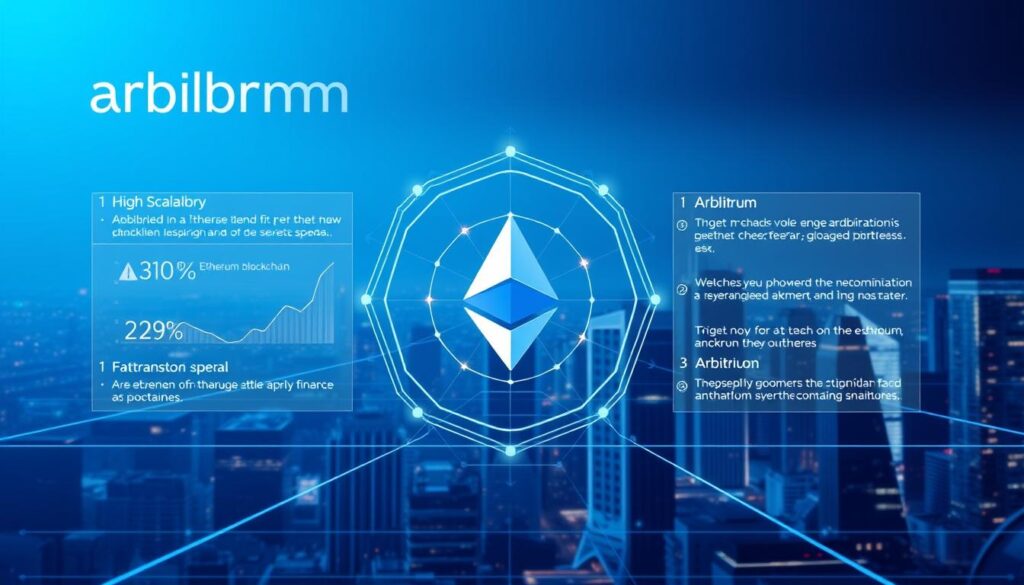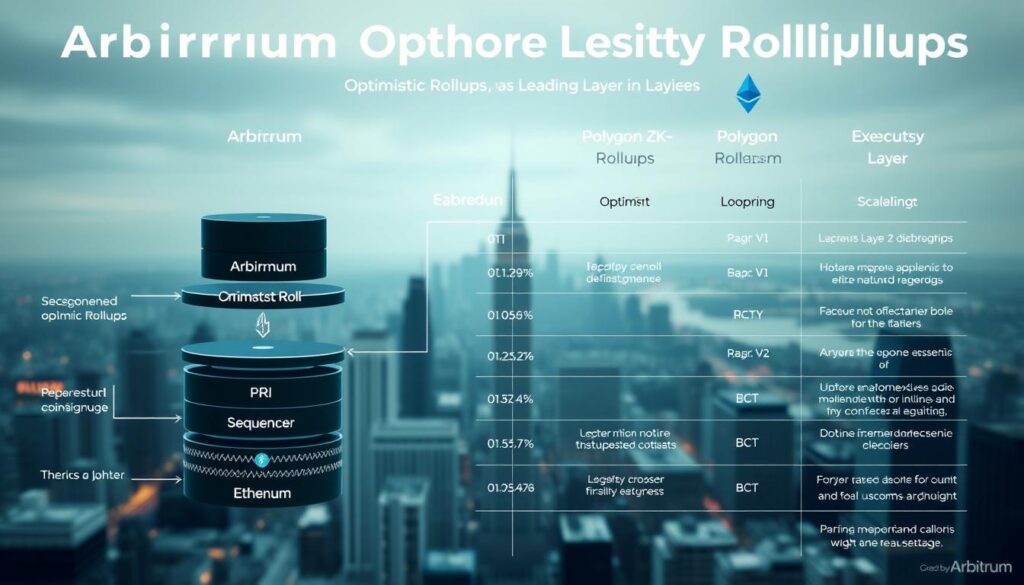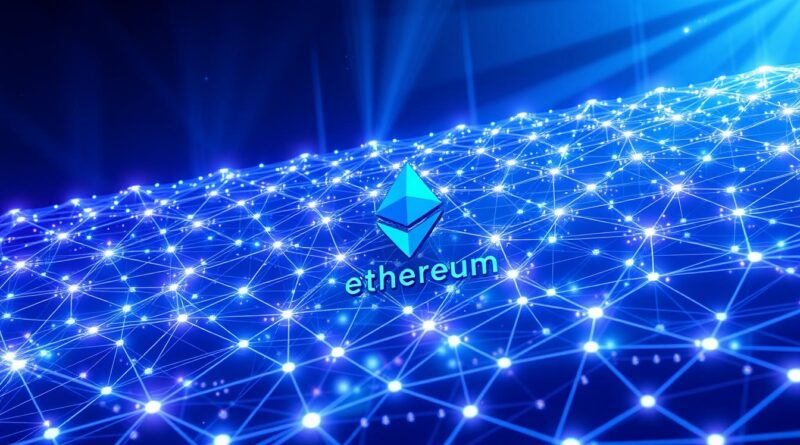Arbitrum (ARB): The Scalable Ethereum Layer-2 Solution
Imagine sending 100 transactions on Ethereum for just one cent. That’s what Arbitrum makes possible, cutting fees by up to 99%. It’s a top Layer 2 solution that uses Optimistic Rollups to handle thousands of transactions off-chain. This makes blockchain tech fast and secure, without losing security.
Since launching in 2021, Arbitrum has become key for big DeFi players like Uniswap and Aave. It helps make NFT marketplaces and lending platforms work better.
Key Takeaways
- Arbitrum’s ARB token powers governance, letting users shape the network’s future.
- Optimistic Rollups cut Ethereum transaction costs by over 99%, enabling faster speeds.
- Arbitrum One handles thousands of transactions per second, far exceeding Ethereum’s capacity.
- Major platforms like OpenSea and Axie Infinity use Arbitrum to reduce user fees and delays.
- ARB’s ecosystem supports DeFi, NFTs, and gaming while maintaining Ethereum’s security standards.
What is Arbitrum (ARB)?
Arbitrum is a blockchain technology built on top of Ethereum. It’s a Layer-2 smart contract platform. Its main goal is to fix Ethereum’s scalability problems while keeping it secure and compatible with current apps.
The Origin Story of Arbitrum
Offchain Labs launched Arbitrum in 2020. It was created to solve Ethereum’s congestion and high fees. They used Optimistic Rollups to bundle transactions off-chain, then finalize them on Ethereum. This made costs lower and increased speed without losing security.
“Arbitrum’s vision is to make scalable blockchain technology accessible to everyone,” stated Offchain Labs in their 2021 whitepaper.
Arbitrum Foundation and Development Team
Offchain Labs, based in New York, leads the development. The team has computer scientists and blockchain experts like CEO Steven Goldfeder and CTO Harry Kalodner. A $120M Series B funding in 2023 valued the project at $1.4 billion, helping it grow.
- 4 million unique addresses interact on Arbitrum
- Over 400 dApps operate, with leading ones holding $100M+ in Total Value Locked (TVL)
The ARB Token Introduction
The ARB token is for network governance and security. Key stats include:
- Initial supply: 10 billion tokens
- 12.75% of tokens airdropped to early users and DAOs
- Median airdrop: 1,250 ARB per eligible wallet
ARB lets holders vote on upgrades through the Arbitrum DAO. The token is given to ecosystem stakeholders: 42.78% goes to a DAO treasury, and 26.94% for team incentives.
Understanding Layer 2 Scaling Solutions
Blockchain technology has big challenges with high transaction volumes and costs. Layer 2 scaling solutions help by making Ethereum work better without losing security. They move transactions off the main Ethereum chain and then group them into one transaction. This makes fees lower and speeds up transactions.
- State Channels: Enable private peer-to-peer interactions before finalizing on-chain.
- Sidechains: Operate as independent blockchains connected to Ethereum.
- Rollups: Bundle multiple transactions into one block for cost efficiency.
Ethereum’s growth has been driven by the need for better scalability. The scalability trilemma—security, decentralization, and performance—has pushed for new ideas. Layer 2 solutions focus on making Ethereum faster and cheaper without losing its core security.
| Type | Mechanism | Advantage |
|---|---|---|
| State Channels | Off-chain agreements finalized later | Low fees, real-time transactions |
| Sidechains | Independent blockchains with two-way asset transfers | High throughput, flexibility |
| Rollups | Batch transactions before Ethereum validation | Maintains security, reduces costs |
Optimistic rollups, like those used by Arbitrum, check transactions off-chain first. This method keeps Ethereum secure while cutting fees by over 90%. Such progress is key for blockchain to be used more widely.
How Arbitrum Works: Technical Architecture
The Arbitrum network uses optimistic rollups to scale. This method batches transactions off Ethereum’s main chain. Then, it sends a single proof to Ethereum for validation.
This approach reduces congestion while keeping the base layer secure. The smart contract platform checks transactions in multiple steps to ensure they are correct.
Optimistic rollups assume transactions are valid unless someone challenges them. If fraud is found, a fraud proof is sent to dispute it. This method keeps Ethereum’s security without giving control to one entity.
The Arbitrum Nitro upgrade in 2022 made things faster. It cut gas fees by up to 90% and made transactions almost instant.
- Key components: Verifier, Virtual Machine (VM), and Manager modules handle off-chain computation and data compression.
- Nova variant: Arbitrum Nova cuts down data storage on Ethereum, making high-volume apps like decentralized exchanges cheaper.
- Trustless security: Even one honest participant can validate transactions, ensuring decentralized oversight without needing trusted operators.
Arbitrum supports over 1,400 audited projects. In 2023, it saw a 50% yearly increase in developers. Its design allows for scaling without losing Ethereum’s security, making it key to Layer 2 innovation.
Key Benefits of the Arbitrum Network

The Arbitrum network tackles Ethereum’s scaling issues with a Layer 2 solution. It uses Optimistic Rollups and Nitro tech for quicker, cheaper transactions. This keeps Ethereum’s security intact.
Reduced Gas Fees Compared to Ethereum
Gas fees on Arbitrum are up to 99% lower than Ethereum’s. Nitro’s tech cuts costs for app interactions. For instance, token transfers on Arbitrum cost cents, not dollars like on Ethereum.
This makes blockchain more accessible to everyone. It’s great for users and developers alike.
Increased Transaction Throughput
Arbitrum can handle hundreds of transactions per second. This is much faster than Ethereum’s 20-40 TPS. Its fraud-proof design ensures safety while boosting speed.
The Nitro upgrade makes it even better for busy apps. This is perfect for DeFi and NFT markets.
Ethereum Virtual Machine (EVM) Compatibility
Arbitrum is easy for developers because it supports EVM. This means projects can move from Ethereum to Arbitrum without changing code. Big apps like Uniswap and OpenSea’s Arbitrum versions show its appeal.
Smart contracts work the same way, saving time and effort.
| Feature | Arbitrum Network | Ethereum Mainnet |
|---|---|---|
| Transaction Speed (TPS) | 1000+ TPS | 20-40 TPS |
| Gas Fees | 90% lower | High |
| EVM Support | Full compatibility | Base layer |
Arbitrum stands out in Layer 2 scaling. It offers speed, low costs, and works with Ethereum. These are key for blockchain to reach more people.
Arbitrum Ecosystem and dApps
Arbitrum’s decentralized finance ecosystem has seen over 1 billion transactions. It hosts a wide range of dApps on its smart contract platform. Developers use Arbitrum to make scalable apps without losing security.
Projects like Pendle Finance and GMX are big in DeFi. NFT platforms and gaming apps also bring more people into Web3.
| Category | Leading Projects | TVL (USD) |
|---|---|---|
| DeFi | Pendle Finance, GMX | $3B / $523M |
| NFT | Space ID, Camelot | N/A |
| Lending | Radiant, Renzo | $130M / $115M |
Decentralized exchanges like GMX support high-volume trading. Radiant’s cross-chain lending bridges $130M in assets. NFT marketplaces like Space ID have issued 300K+ items.
Gaming dApps use Arbitrum’s low fees to grow play-to-earn models. Tools like XY Finance make cross-chain swaps easy across 20 EVM networks.
- Pendle’s $3B TVL leads yield farming on Arbitrum
- Arbitrum Nova handles 100x faster transactions than Ethereum
- Over 250K users own .arb domains for Web3 identity
Developers enjoy low gas fees, starting at $0.02. This helps projects like Degen Chain grow fast. This growth makes Arbitrum a top smart contract platform for scalable apps.
ARB Tokenomics and Distribution
ARB tokenomics aims to reward users, developers, and network security. The Arbitrum ecosystem has a 10 billion token cap with a 2% annual inflation rate. This inflation helps fund upgrades. Initially, 35.28% of tokens went to the Arbitrum DAO treasury for governance and security.
Initial Token Distribution
Stakeholders got tokens with strict lockup rules. The team and contributors hold 26.94% of tokens, vesting over four years starting April 2023. Users earned 11.62% through airdrops for their activity during Nitro launch.
To get airdrops, users needed at least 3 points. Points came from actions like bridging funds or frequent transactions.
| Points Earned | ARB Entitlement |
|---|---|
| 3 | 1,250 |
| 6 | 3,250 |
| 12+ | 10,250 |
Token Utility and Value Proposition
ARB is used for transaction fees, governance voting, and staking. Its value comes from being a governance tool for upgrades and fee cuts. In March 2024, $1.2B in tokens were unlocked, boosting exchange liquidity.
ARB staking rewards incentivize participants to strengthen network security while earning yields.
Staking and Rewards
Users stake ARB to validate transactions and earn rewards. The 2% annual inflation funds staking pools. This rewards those who secure the network. Lockup periods ensure long-term commitment, with the Arbitrum Foundation’s tokens vesting over four years starting April 2023.
Arbitrum Governance Model
Arbitrum’s governance model lets ARB holders guide the Arbitrum network’s growth. They make key decisions on upgrades, security, and growth through decentralized ways. This ensures the network stays true to community goals.
This system is key for decentralized finance and blockchain innovation. It balances efficiency with decentralization.
“The Constitution serves as the foundational framework guiding all governance decisions.”
The Arbitrum DAO
TheArbitrum DAO works under a Constitution that outlines its rules. Important decisions, like updating security or adding new chains, need community approval. A 12-member Security Council, chosen by the community, reviews proposals to ensure safety.
The Constitution also lets the DAO change the Council’s power. This keeps the system adaptable without losing decentralization.
Voting Mechanism and Proposal Process
Proposals go through a two-step process:
- A non-binding “Temperature Check” to gauge initial support
- A binding on-chain vote requiring at least 10% of total $ARB tokens to vote for execution
Voting has six stages: Draft creation, on-chain publication, voting period, finalization, queuing, and execution. If inactive, holders can delegate their votes to trusted delegates. This encourages more people to participate.
Community Participation
ARB holders can see their voting power with the “My Voting Power” tool. They can delegate tokens or vote directly, with more tokens giving more influence. Over 1 billion $ARB are delegated, showing the community’s growing involvement.
This model makes sure the Arbitrum network grows in a clear and trustworthy way. It’s a key part of decentralized finance.
Comparing Arbitrum with Other Layer 2 Solutions
Arbitrum’s use of optimistic rollups makes it stand out among Layer 2 scaling solutions. It handles 8–15 transactions per second (TPS), unlike Ethereum’s 14 TPS. Arbitrum Nova boosts this to 40,000 TPS, rivaling Optimism and zkSync.
| Solution | TPS | Transaction Fees | Security Model |
|---|---|---|---|
| Arbitrum One | 8–15 | $0.01–$0.50 | Ethereum-equivalent security |
| Optimism | 3–5 | $0.10–$1.00 | Optimistic rollup (single-round fraud proofs) |
| zkSync | 2,000+ | Near-zero fees | Zero-knowledge proofs (privacy-focused) |
Arbitrum uses optimistic rollups with a multi-round fraud proof system. Optimism has single-round proofs, making Arbitrum’s dispute costs lower but finality time longer. Arbitrum Nova’s fees drop to $0.01 per transaction, great for gaming and social apps. zkSync focuses on privacy but is slower.

Arbitrum’s ecosystem has $15.94B in TVL, more than Optimism’s $9.36B. It has 989,000 Twitter followers and 345,000 Discord members, showing strong community support. Developers will find full EVM compatibility with Arbitrum One’s AVM. Arbitrum Nova’s AnyTrust model balances cost and security for high-volume use cases.
How to Use Arbitrum: A Step-by-Step Guide
Starting with Arbitrum is easy. Just follow these steps to enjoy faster transactions and lower fees. This guide helps you get into Arbitrum’s world, whether you’re moving assets or checking out dApps.
Setting Up Your Wallet for Arbitrum
To start, add Arbitrum chains to your wallet. You can use MetaMask or OKX Wallet. Here’s how:
- Open your wallet and go to the Network settings.
- Click Add Network and enter the needed details:
| Chain Name | Chain ID | RPC URL |
|---|---|---|
| Arbitrum One | 42161 | https://arb1.arbitrum.io/rpc |
| Arbitrum Nova | 42170 | https://nova.arbitrum.io/rpc |
| Arbitrum Sepolia (Testnet) | 421614 | https://sepolia-rollup.arbitrum.io/rpc |
Bridging Assets to Arbitrum
To move assets to Arbitrum, you need to bridge them. The process varies but here’s a general outline:
- Go to the Arbitrum Bridge.
- Pick tokens like ETH or ARB to move. Fees are usually $1–$5, based on the amount.
- Wait 15–30 minutes for it to finish. Moving back to Ethereum takes 7–8 days.
Interacting with Arbitrum dApps
Check out these top DeFi apps on Arbitrum:
- Uniswap for swaps on Arbitrum One
- Aave for lending and borrowing
- Use ARB tokens for voting in protocols
Always check contracts on Arbiscan before using them. Use GasNow to keep an eye on gas fees.
Challenges and Limitations of Arbitrum
Arbitrum is a top Layer 2 scaling solution on Ethereum. It aims to lower fees and speed up transactions. But, it must tackle centralization risks, technical hurdles, and strong competition.
Centralization Risks
Arbitrum’s sequencer is controlled by Offchain Labs, leading to governance risks. Yet, users keep ARB tokens in their own wallets. This means they must manage their private keys carefully to avoid losing funds.
Technical Barriers
Optimistic rollup mechanics cause delays. Withdrawals can take up to 24 hours. This complexity might slow down advanced smart contracts, even though Arbitrum handles 40,000 transactions per second.
Market Competition
Polygon has 19,000 dApps, while Arbitrum has 228. This shows a tough battle in the Layer 2 market. With cheaper fees, rivals like Optimism challenge Arbitrum’s 64.5% TVL lead. Regulatory changes, like in the Philippines, also pose risks.
The Future Roadmap of Arbitrum
Arbitrum is working hard to make Ethereum faster and cheaper. It wants to make transactions quicker and cheaper. This will help Ethereum become more popular.
They are focusing on new tech, making decisions more open, and growing the community. This will make Arbitrum better for everyone.
- Optimizing rollup efficiency to handle thousands of transactions per second.
- Integrating with Ethereum’s upcoming sharding upgrades to improve cross-chain interoperability.
- Expanding the Arbitrum DAO’s role in protocol decisions via community voting.
| Focus Area | 2023-2024 Targets |
|---|---|
| Security | Scaling the Arbitrum Security Council to 15 members by 2024. |
| Adoption | Launch new developer grants to grow the dApp ecosystem. |
| Decentralization | Phased transfer of governance powers to token holders by 2025. |
Arbitrum’s Nitro stack has already made fees very low. They plan to make Ethereum even faster and cheaper. This includes working on new ways to connect different blockchain layers.
They also want to make it easier for new developers to join. With so many users every week, Arbitrum is all about making things better and safer for everyone.
Conclusion
Arbitrum is a top Layer 2 scaling solution for Ethereum. It tackles big problems like high fees and slow speeds. By moving transactions to its Layer 2 network, Arbitrum handles thousands of transactions per second.
This makes Ethereum faster and cheaper for users in DeFi and more. Its design works well with Ethereum’s tools and smart contracts. This makes it easy for developers to build apps like Uniswap and Aave.
Arbitrum has over 521 apps and an $8 billion TVL. The ARB token is key for governance and security. It’s currently at $0.95 and has a small circulating supply, showing room for growth.
Upcoming updates like Stylus and Timeboost aim to draw more developers. They also aim to solve problems like MEV and centralization risks.
Arbitrum faces competition but is set to be a key player. It could see ARB reach $3.41 by 2025, showing investor trust. As DeFi grows, Arbitrum’s role in fast, affordable transactions is crucial for Ethereum’s success.
Its mix of innovation and partnerships makes it a key part of blockchain’s future.




